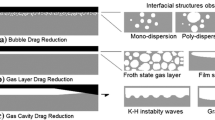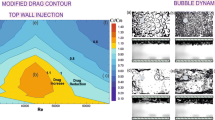Abstract
In the present study, experiments were conducted in a rectangular mixing conduit of an effervescent atomizer to quantify the effect of addition of drag reducing agent on bubble formation from an orifice in horizontal cross-flow. Modified bubble formation behavior in horizontal liquid cross-flow after addition of drag reducing agent was investigated. Shadowgraph images of bubbles evolving at an orifice were taken using a high-speed camera; bubble size and velocity were measured. High molecular weight cationic polyacrylamide was used as a drag reducing agent. Increase in the size of bubble with increase in concentration was observed. Particle image velocimetry in the upstream flow with drag reducing agent provided velocity profile and turbulence characteristics showing of the role of mean flow on increasing the bubble size.
Graphical abstract











Similar content being viewed by others
Abbreviations
- DRA:
-
Drag reducing agent
- LDV:
-
Laser doppler velocimetry
- PIV:
-
Particle image velocimetry
- rms:
-
Root mean square
- wppm:
-
Weight parts per million
- LPS:
-
Litres per second
- SLPM:
-
Standard liter per minute
- y :
-
Distance across the channel (mm)
- x :
-
Distance along the channel (mm)
- Q l :
-
Liquid flow rate (L/s)
- U :
-
Bulk velocity (m/s) \([U = Q_{l} /{\text{Cross-sectional Area of Conduit}}* 1000]\)
- v x :
-
Streamwise velocity (m/s)
- v y :
-
Spanwise velocity (m/s)
- \(v_{x}^{\prime }\) :
-
Streamwise velocity fluctuations (m/s)
- \(v_{y}^{\prime }\) :
-
Spanwise velocity fluctuations (m/s)
- |v′| :
-
Magnitude of velocity fluctuations (m/s) \(\left[ {|v^{{\prime }} | = \sqrt {\left( {v_{x}^{{\prime }} } \right)^{2} + \left( {v_{y}^{{\prime }} } \right)^{2} } } \right]\)
- d :
-
Channel hydraulic diameter (mm)
- d b :
-
Bubble diameter (mm)
- d o :
-
Orifice diameter (mm)
- ρ l :
-
Liquid density (kg/m3)
- σ :
-
Surface tension (N/m)
- C D :
-
Drag coefficient
References
Acharya A, Mashelkar RA, Ulbrecht JJ (1978) Bubble formation in non-Newtonian liquids. Ind Eng Chem Fundam 17(3):230–232
Costes J, Alran C (1978) Models for the formation of gas bubble at a single submerged orifice in a non-Newtonian fluid. Int J Multiph Flow 4:535–551
Davidson JF, Schuler BOG (1960) Bubble formation at an orifice in a viscous liquid. Trans Inst Chem Eng 38:144
Forrester SE, Rielly CD (1998) Bubble formation from cylindrical, flat and concave sections exposed to a strong liquid cross-flow. Chem Eng Sci 53:1517–1527
Ghaemi S (2009) Investigation of effervescent atomization using laser-based measurement techniques. M.Sc. thesis, University of Alberta
Gomez JI (2010) Infuence of bubble size on an effervescent atomization. M.Sc. thesis, University of Alberta
Huang X, Wang X, Liao G (2008) Visualization of two phase flow inside an effervescent atomizer. J Vis 11:299–308
Ishiguro S, Hartnett JP (1992) Surface tension of aqueous polymer solutions. Int Commun Heat Mass Transf 19:285–295
Jiang S, Fan W, Li H (2007) Bubble formation in non-Newtonian fluids using laser image measurement system. Chin J Chem Eng 15(4):611–615
Kennedy PK (1995) Flow analysis of injection molds. Hanser, New York. ISBN 1-56990-181-3
Konstantinov D, Marsh R, Bowen P, Crayford A (2010) Effervescent atomization for industrial energy-technology review. Atom Sprays 20(6):525–552
Kulkarni AA, Joshi JB (2005) Bubble formation and bubble rise velocity in gas-liquid systems, a review. Ind Eng Chem Res 44(16):5873–5931
Kumar R, Kuloor NR (1970) The formation of bubbles and drops. Adv Chem Eng 8:255–368
Liu C, Liang B, Tang S, Zhang H, Min E (2010) A theoretical model for the size prediction of single bubbles formed under liquid cross-flow. Fluid flow and transport phenomena. Chin J Chem Eng 18(5):770–776
Luchik TS, Tiederman WG (1988) Turbulent structure in low concentration drag reducing channel flows. J Fluid Mech 190:241–263
Lumley JL (1973) Drag reduction in turbulent flow by polymer additives. J Polymer Sci Macromol Rev 7:263–290
Marshall SH (1990) Air bubble formation from an orifice in liquid cross-flow. PhD thesis, University of Sydney
Sen D, Balzan MA, Nobes DS, Fleck BA (2014) Bubble formation and flow instability in an effervescent atomizer. J Vis 17:113–122
Sovani SD (2001) High pressure gas–liquid flow inside and effervescent diesel injector and its effect on spray characteristics. PhD thesis, Purdue University
Toms BA (1949) Some observations on the flow of linear polymer solutions through straight tubes at large Reynolds numbers. In: Proceedings 1st international congress on rheology. North Holland, Amsterdam, pp 135–141
Tsuge H, Hibino SI (1983) Bubble formation from an orifice submerged in liquids. Chem Eng Commun 22:63–79
Warholic MD, Heist DK, Katcher M, Hanratty TJ (2001) A study with particle image velocimetry of the influence of drag reducing polymers on the structure of turbulence. Exp Fluids 31:474–483
White CM, Somandepalli VSR, Mungal MG (2004) The turbulence structure of drag reduced boundary layer flow. Exp Fluids 36:62–69
Author information
Authors and Affiliations
Corresponding author
Rights and permissions
About this article
Cite this article
Bhambri, P., Sen, D., Negi, Y.S. et al. Effect of drag reducing agent on bubble formation in horizontal liquid cross-flow. J Vis 19, 225–235 (2016). https://doi.org/10.1007/s12650-015-0315-9
Received:
Revised:
Accepted:
Published:
Issue Date:
DOI: https://doi.org/10.1007/s12650-015-0315-9




